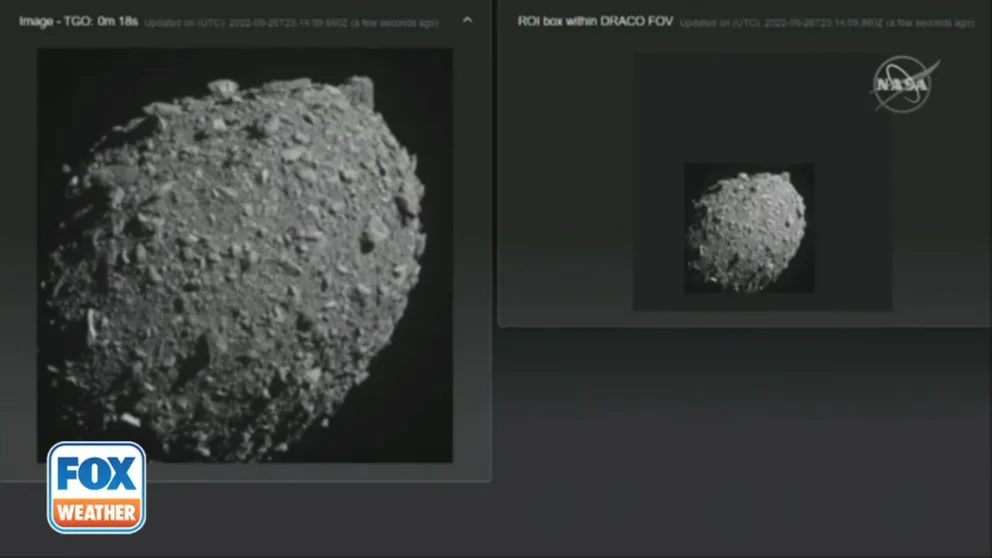'Loss of signal:' NASA successfully crashes DART spacecraft into asteroid for planetary defense test
NASA's DART spacecraft hit its target, asteroid Dimorphos, at 7:14 p.m. ET. The spacecraft sent back images up until it smashed into the asteroid 7 million miles from Earth.
NASA DART spacecraft sees asteroid Dimorphos before impact
The National Aeronautics and Space Administration spacecraft sees asteroid Dimorphos before impact
NASA's DART spacecraft crashed head-on into a small asteroid on Monday evening to test one of the potential ways to deflect an asteroid when one is headed toward Earth.
Since launching last fall, the Double Asteroid Redirect Test (DART) spacecraft has been traveling toward a binary asteroid system – the larger Didymos and its smaller moonlet Dimorphos, about 7 million miles from Earth. The pair of asteroids are considered near-Earth asteroids because their orbit will one day take the asteroids zooming by Earth but are no threat to our planet.
On Monday, DART used its autonomous navigation to hone in on the asteroid moonlet Dimorphos, then charge head first at about 15,000 mph, acting as a battering ram into the space rock.
NASA TEAM CONFIDENT IT WILL SUCCESSFULLY KILL ITS DART SPACECRAFT AFTER ASTEROID COLLISION
The Johns Hopkins University Applied Physics Laboratory (JHUAPL) in Maryland manages the spacecraft for NASA, and teams in the APL mission operation center have worked toward this moment for more than five years.
At 7:14 p.m. ET DART slammed into asteroid Dimorphos.
Here's what unfolded during the dramatic result of NASA's first planetary defense test.
One blob of light becomes two

The first faint image of the asteroid system Didymos as seen by DART's camera DRACO about 2 hours before impact. (Image: NASA/ JHAPL)
DART Mission Systems Engineer Elena Adams, with JHUAPL, said the mission operations center, or MOC, was "all hands on deck" 24 hours before impact.
NASA's associate administrator for science Thomas Zurbuchen told FOX Weather on Monday the team is excited and ready.
"As always, when you are in these kinds of moments, it's a little bit nervous as well because you think about all the things that could go wrong," Zurbuchen said. "This team has been enormously strong coming together and doing this work here out of Johns Hopkins APL, but also with people around the country to get this mission ready, get it launched during COVID times, when very few missions were launching elsewhere, and having it on collision course now later tonight."
DART's only instrument, the Didymos Reconnaissance and Asteroid Camera for Optical Navigation or DRACO, sent back near real-time images during the final approach.
At first look, Didymos appeared only as a faint point of light surrounded by darkness. As DART approached the images improved.
On Monday afternoon DART was already communicating with the Deep Space Network antenna in Canberra, Australia to send back images of the asteroid pair.
About 4 hours before impact, the spacecraft began working autonomously to navigate to its end.
One hour before impact, DART used its relative-navigation system called SMART Nav to hone in on Didymos. A little over one hour to impact, SMART Nav had also detected Dimorphos. Slowly, the smaller Dimorphos came into focus as the spacecraft approached from 17,000 miles away to zero.
IMAGES FROM ASTEROID-SMASHING DART MISSION EXPECTED TO BE 'STUNNING'
During a final poll about 30 minutes before impact, Adams said all systems were "go" and everything was going well for the spacecraft's systems.
"We are now precision lock and still tracking Dimorphos," the team confirmed in the last milestone, as the spacecraft began ignoring Didymos and started zooming toward Dimorphos.
About 2.5 minutes before impact, Smart Nav turned off, and DART's camera took the first clear photos of Dimorphos before it smacked into its subject.
"I'm looking forward to that moment where for the first time we lay eyes on that other object, the one that we want to hit," Zurbuchen said earlier on Monday.
Dimorphos is only about 530-feet-wide and wasn't fully in focus and clear until just moments before impact.
The team at APL said they are excited to learn more about the asteroid system by studying the final images.
"We're going to be able to tell a lot about how the (asteroid) system formed and what it has experienced over time as we look at these images closely," DRACO instrument scientist Carolyn Ernst, with APL, said post impact.
Ernst described Dimorphos as "egg-shaped with a bunch of boulders clearly on top, like it's a pile of rubble."
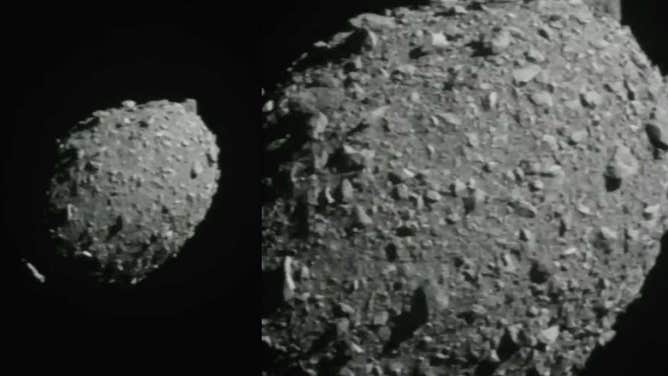
Asteroid Dimorphos as seen by NASA's DART spacecraft seconds before impact. (Image: NASA/JHUAPL)
The last image of the rocky asteroid was taken about 2.5 seconds before DART flew headfirst into the asteroid.
"Dimorphos is becoming bigger and bigger in this camera … until the last image is being sent off just seconds before the impact," Zurbuchen said.
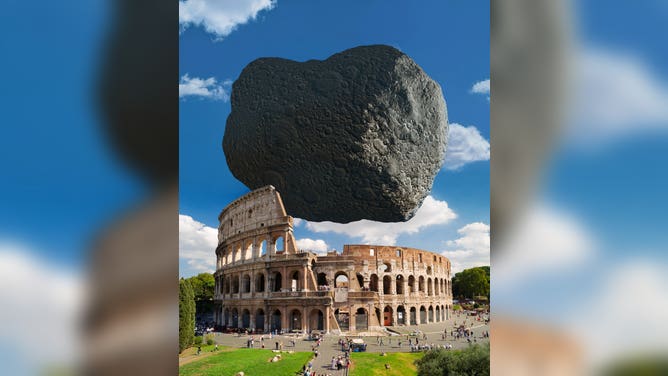
The Dimorphos asteroid to scale with Rome's Colosseum. (Image: ESA)
Seconds after impact, DART's team confirmed a "loss of signal" from the spacecraft.
DART navigation lead Dr. Julie Bellerose said that even though DART was designed to end in a destructive impact, it was still a bit emotional seeing the conclusion of years of work.
"I shed a tear when, you know, the last image that didn't come out fully," Bellerose said. "There's a lot of emotion in those critical times and we had some surprises in the last few weeks and a lot of teamwork going on."
Because of the 8-second delay from DART's signal to Earth, photos continued to come through the mission operations center in Maryland until the feed cut out.
What is the goal?
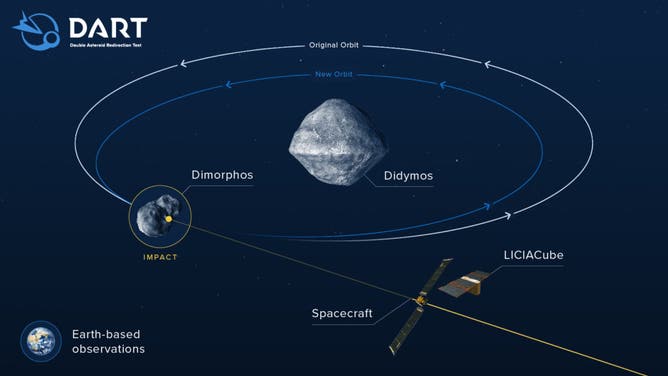
DART and LICIACube shown on a graphic with the binary asteroid system Didymos and Dimorphos. (Image: NASA/ JHUAPL)
Now that DART has hit Dimorphos as planned, NASA will be able to test the kinetic impactor Earth defense theory.
"The point of a kinetic impactor is you ram your spacecraft into the asteroid you're worried about, and then you change its orbit around the Sun by doing that," Johns Hopkins Applied Physics Laboratory Planetary astronomer Andy Rivkin said.
DART won't change the orbit of Didymos. It aims to change the speed of the moonlet, Dimorphos, by just a tiny percentage, maybe an inch or two a second.
The spacecraft will not change the orbit enough that Didymos or Dimorphos will become a threat to Earth.
How will NASA know if it worked?
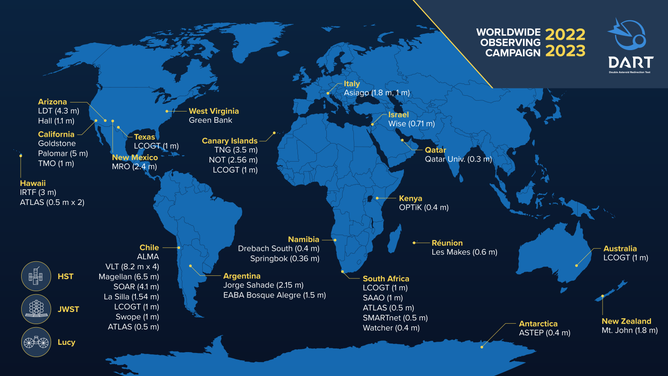
Graphic of the over three dozen telescopic facilities in space and around the globe that are planned to observe the Didymos asteroid system in support of DART’s global observation campaign after impact. These observations will confirm if DART’s impact successfully deflected the asteroid moonlet Dimorphos and decreased its orbital period around its asteroid companion Didymos. (Credit: NASA/Johns Hopkins APL/Nancy Chabot/Mike Halstad
The first indication was the loss of signal from DART because the spacecraft did not survive the impact.
ITALIAN SATELLITE WILL WITNESS DART'S ASTEROID SMASH IN THE NAME OF PLANETARY DEFENSE
Following the smashing achievement of DART's impact, Adams said Earthlings "should sleep better" at night, calling the first planetary defense test a success.
DART brought along a companion in the form of a tiny spacecraft built by the Italian Space Agency (Agenzia Spaziale Italiana) called LICIACube.
Three minutes after DART made a direct hit, LICIACube flew by the asteroid to survey the damage. The Italian spacecraft will record the impact area, debris and DART's final moments using two cameras, LUKE and LEIA.
Around the world scientists using ground-based telescopes monitored the binary asteroid system's orbit during the impact and after. Already, researchers at ground telescopes are reporting what they saw.
Multiple spacecraft were also watching the crash when it happens, including the James Webb Space Telescope, Hubble Space Telescope and NASA's Lucy spacecraft. Data from those spacecraft will come back a day or two after impact.
Over the next few months, mission scientists should get confirmation of the exact orbital change made by DART's hit.
A follow-up European Space Agency mission launching in 2024, called HERA, will visit Didymos and Dimorphos to check the work or DART and see the impact area.
